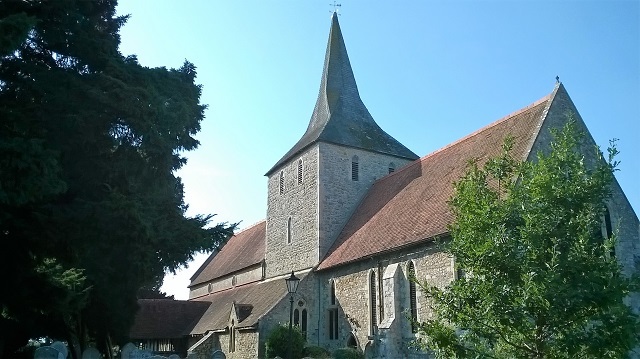
History
The earliest firm evidence of Christianity on Hayling Island dates back to Anglo-Saxon times, although it is quite possible that the religion was practised on the island in the last century or two of Roman rule. There was a Saxon church dedicated to All Saints, which probably now lies under water following the loss of a sizeable portion of the island to the sea in 1324.
Queen Emma, wife first of Ethelred the Unready and then of Canute, gave the manor of Hayling to the monks of St Swithun at Winchester Cathedral. After the Norman conquest, William the Conqueror granted most of Hayling to the Benedictine Abbey of Jumièges in Normandy, which received its agricultural income. There followed a long period of legal disputes between Jumièges Abbey and the Winchester Monks, who held on to a small part of northern Hayling. At various times over the next few centuries, during times of hostility with France, English monarchs took control of priories owned by French abbeys, including that of Hayling Island.
The Church
Building of the Priory Church of St Mary's started in about 1250, when it became clear that the Church of All Saints was severely threatened by sea flooding. At this time the Island was still largely in the possession of Jumièges, although in 1294 Edward I took control of the priory, which remained in royal possession for some 30 years. Carved on a panel in the choir stalls are the Arms of Jumièges. One of the first priors is probably buried under a memorial stone in the chancel of St Mary's.
Henry V deprived all French abbeys of their rights in relation to English priories, and in 1414 he granted the priory of Hayling to the Carthusians of Sheen. From then on it seems likely that the prior of Hayling leased most of Hayling Island from the Carthusians.
In 1539, following the dissolution of the monasteries, Henry VIII granted the priory, along with the manor of Hayling, to Trinity College, Arundel. Subsequently the manor passed into the possession of the Dukes of Norfolk, who owned it until 1825.
The most famous person associated with the priory of St Mary's is Thomas Hoccleve, a royal official and a major poet of the school of Chaucer. In 1394 Richard I granted Hoccleve the right to bed and board at the priory. This sort of grant was a standard way to increase the emoluments of royal officials, and Hoccleve probably exchanged the right for money, possibly a regular income paid by the priory.
In 2010 St Mary's was refurbished. Victorian pews were removed and replaced with chairs, giving the church a much lighter and more flexible character. Repairs were made to the base of pillars damaged when the pews were put in, and other alterations were made.
The Cache
At the published co-ordinates you will find a small bench underneath a magnificent ancient Yew tree which is believed to be around 2000 years old.
- How many letters in the surname of the person commemorated on the bench? = A
- The person on the bench was born in 192B
Now make your way into the church through the South door. There are lighting controls just inside the door to your right as you enter which will allow you to turn the interior lights on and off as necessary. Please leave them in the state that you found them as you leave.
You need to find several pieces of information within the church. To help you, here are some places to look:
- Brass plates underneath windows
- Hymn boards
- In stained glass windows
- On boards next to the North door
Here is what you need to find:
- Henry, son of Hannah and Harry, died aged 3C years old
- Alice Startin was born DEth July 1863
- Alfred King was born in 190F
- The surname of the vicar between 1369-70 has G letters
- Lucy McEuen was born in 185H
- Thomas Edmondson became vicar in 14J6
You can get to GZ by leaving the churchyard in a direction away from the main road. It cannot be accessed from nearby streets. You can find the cache at N 50° 4(H+B).(A+H)(J-F)(C-F) W 000° 5(B+D).(D+G)(J-G)(E+E-A). The checksum for all 15 digits of the final co-ordinates is 65. Alternatively here is a geochecker which also contains trailhead co-ordinates. You are looking for a micro container covered in black tape.
****************** ********************
For full information on how you can expand the Church Micro series by sadexploration please read the Place your own Church Micro page before you contact him at churchmicro.co.uk
See also the Church Micro Statistics and Home pages for further information about the series.
****************** *******************